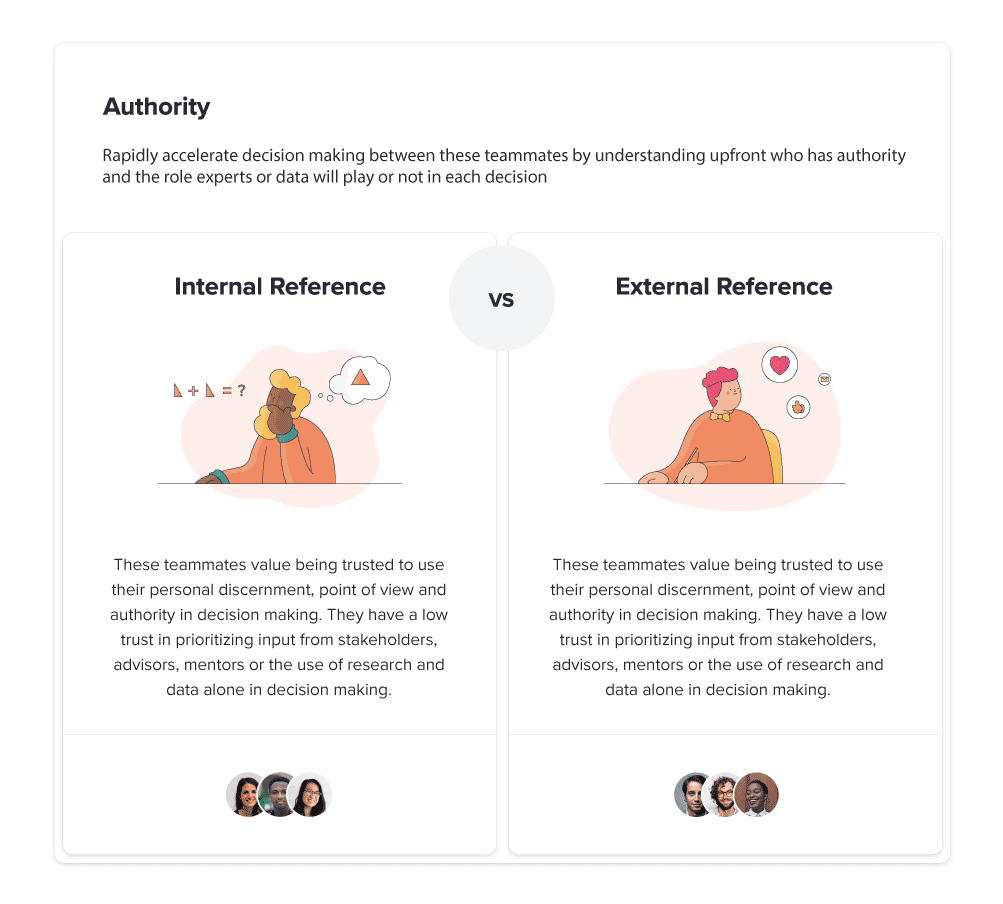6 team leader qualities inspiring trust and productivity at work
77% of businesses are experiencing a leadership gap.1 As a result, many businesses don’t have enough professionals with the necessary qualities to effectively lead their teams.
To bridge the gap, this article outlines six essential team leader qualities. It offers tips on how to motivate your team and become an effective leader.
We also show you how the Fingerprint for Success tools enable you to develop your leadership team and improve overall performance.
Who is a team leader, and what is their role?
Team leadership is a managerial role that involves overseeing the activities of other people in the department, managing resources, resolving issues, and driving the team toward achieving company goals.
A team leader holds a leadership position within an organization and is responsible for managing a specific group of employees within a department. This group of employees are “direct reports.”
As a true leader your primary role is to manage your team in a way that drives company success. This involves:
- Ensuring tasks are completed on time and to a high standard
- Offering team members the guidance, training, and mentoring they need to excel in their roles
- Breaking down company goals into actionable steps and communicating these to team members
- Managing the allocation of resources, including personnel, budget, and equipment, to ensure the team has what it needs to accomplish tasks
- Monitoring and evaluating team performance
- Encouraging open and transparent communication within the team
- Identifying and solving problems that stop the team's progress
6 qualities of effective team leaders
1. Communication skills
Clearly defining each team member's roles and responsibilities means everyone understands what is expected of them. This reduces confusion and ensures tasks are completed without falling through the cracks.
As many as 72% of business leaders have seen a significant boost in team performance and overall productivity as a result of this clarity.2
Some examples of excellent communication skills include: active listening, written, verbal, and nonverbal communication, empathy, conflict resolution, negotiation, the ability to give constructive feedback, and effective presentation.

2. Emotional intelligence (EQ)
EQ drives 58% of successes in the workplace.3 That’s because leaders with high emotional intelligence connect better with their teams. They know how to communicate and assign responsibilities to each team member based on their preferences and strengths.
As a result, they are more likely to build strong interpersonal relationships with their teams, motivate them, and make better decisions.
Some examples of emotional intelligence skills are self-awareness, intrinsic motivation, empathy, teamwork, cultural awareness, flexibility, resilience, and the ability to influence people (without being manipulative).
3. Strong decision making skills
As a team leader, you are responsible for ensuring employees stay on track, achieve desired results, and meet deadlines. When challenges arise, you have to find ways to ensure the project stays on course and is completed on time.
To do this, you need to make sound decisions like allocating resources such as time, budget, and manpower efficiently (and reallocating, as needed) to support project requirements and team needs. These decisions boost team morale and keep everyone engaged.
Some examples of decision-making skills are critical long-term thinking, resource allocation, time management, problem solving, prioritization, and planning.
4. Ability to motivate and inspire others
High morale translates into higher levels of motivation among team members. And motivated people are more likely to put in their best effort at work. It’s no wonder successful leaders ranked ‘morale’ as more important than ‘talent’ when ranking the attributes of an effective team.4
Your ability to motivate and inspire your team creates a positive work environment. This leadership skill makes team members more likely to enjoy their work, feel a sense of belonging, and have a positive outlook.
Some examples of ways to motivate and inspire your team are by providing autonomy, celebrating achievements, offering career development opportunities, adapting to change, and helping others navigate change.

5. Leading by example
This is the most important quality, as it forms the foundation of effective team leadership.
Authentic leadership starts with understanding that your actions and behaviors have a profound impact on your team's performance and overall success.
When you consistently demonstrate the behaviors, work ethic, and values you expect from your team, you build trust and credibility. Team members are more likely to follow a leader they trust and respect.5
This attitude also contributes to a positive work culture, which in turn, leads to higher morale, job satisfaction, and a more collaborative work environment.
Some ways to lead by example include demonstrating integrity, continuous learning, accountability, positivity, innovation, constructive criticism, and treating your team the way you’d want to be treated if you were in their shoes.
6. Ability to empower and delegate to others
Delegating tasks and responsibilities lets you make the most efficient use of available resources, including time, skills, and expertise. This way, you can assign them based on your team's individual strengths and optimize productivity.
Plus, delegation frees up time for you to focus on high-priority tasks, strategic planning, and decision-making.
But you have to empower your team, so they can take on these tasks and deliver similar results to you. Empowered employees are more engaged in their work.6 They feel a sense of responsibility and ownership, leading to increased job satisfaction and commitment.
One way to empower and delegate the right tasks to your team is to understand what their strengths and motivations are.
F4S uncovers your team’s strengths and growth opportunities, as well as what motivates them. To begin, invite your team to take the free assessment. Once each team member completes the assessment, you can access the results through the 'Teams' tab, under ‘Motivations’.
-min.gif)
The team ‘Culture’ tab provides personalized insights about your team’s intrinsic motivations. This report also stacks up their motivations against those of other teammates. With these insights, you can delegate the right tasks to your team.
.png)
5 stages of team development
Bruce Tuckman's model of team development is a popular framework that outlines five stages teams go through as they form, mature, and work together.7
Let’s go through the 5 stages:
1. Forming
In this initial stage, team members are often cautious and polite. They are getting to know each other and may be uncertain about their roles and the team's goals. Your job as the team leader here is to provide guidance, set clear expectations, and ensure everyone understands their responsibilities.
As part of your team’s overall report after taking the F4S assessment, you get the Power of Difference report, which highlights the most significant differences in individual team members’ work styles. Use this tool during the team formation stage, to proactively identify and address conflicting work styles before they escalate.

2. Storming
As team members become more comfortable with each other, differences in opinions, personalities, and working styles will often lead to conflicts.
To navigate this phase successfully, facilitate open communication, mediate conflicts, and encourage collaboration.
If your hybrid or remote team uses Zoom for video calls, you can mediate conflict more easily using the F4S Zoom integration. The integration makes it easy to understand how each party prefers to communicate, so you know the best way to address the issue and adjust your messages based on their communication style. It also shows you how they prefer to make decisions during the call, so you can respond in a way that suits them. This eliminates communication barriers and makes sessions more productive.
3. Norming
In this stage, team members start to resolve their differences and establish common goals and norms. They become more cohesive and collaborative, with improved mutual trust and respect.
Here, your leadership role is straightforward. Continue to support team cohesion and ensure that everyone has a clear understanding of their roles, encourage open communication and reinforce positive behaviors.
4. Performing
At this stage, the team is highly productive, and members work together effectively. They are focused on achieving their goals and delivering results.
Your role becomes more hands-off as the team is self-directed. You should provide support as needed, monitor progress, and celebrate achievements.
5. Adjourning
In this final stage, the team's work is completed, and members may experience a sense of closure. If the team was successful, there’ll be a feeling of accomplishment. However, if the team faced challenges or conflicts, there could be a sense of loss or disappointment.
Support team members to reflect on their accomplishments, provide honest feedback, and assist with the transition to new projects or teams. Also, acknowledge and celebrate the team's achievements.

Tip: Not all teams go through these stages in order. Some teams may cycle to earlier stages if they face significant changes or challenges.
Also, the time spent in each stage varies depending on team size, task complexity, and team dynamics.
However, understanding these stages will allow you to navigate the process better, improve team performance, and achieve success.
5 ways to motivate your team as a leader
1. Set clear expectations
Clear expectations ensure all team members understand their roles, responsibilities, and the goals they are working toward. This alignment prevents confusion and misdirection; you can hold them accountable for deliverables.
How to set clear expectations
Clearly outline the roles and responsibilities of each team member.
Provide a detailed job description or task list for each role so everyone knows what’s expected of them and how they contribute to the company’s goals.
Also, set SMART Goals. This means breaking down large goals into smaller, achievable milestones and establishing deadlines for completion.
For example, a SMART goal for the social media manager (from the marketing team) could be, "Increase organic Instagram engagement by 20% in the next quarter." This goal tells the employee what to achieve within a specific timeframe and by how much.
2. Run a team dynamics workshop
A team dynamics workshop is a structured opportunity for team members to participate in activities and conversations. This helps you understand each person better, build trust, and strengthen work relationships.
Plus, it often includes exercises that strengthen critical team leader qualities such as active listening, constructive criticism, and conflict resolution.
How to run an effective team dynamics workshop
First, define the goal of the workshop. What outcomes do you want to achieve? Then select appropriate team-building activities and exercises that address the team's needs and shared goals.
Also, choose a suitable location and prepare the necessary materials and facilitators or trainers for the activities.
During the session, actively participate in the workshop alongside your team members, as your involvement sets a positive example and reinforces the importance of the workshop. Encourage open and honest communication during activities, be receptive to feedback, and be willing to address concerns. Read more about How to run a team dynamics workshop.
3. Provide constructive feedback
Constructive feedback ensures team members understand their strengths and areas for improvement, which gives them clearer direction on the path to take to improve their skills and advance their careers.
Regular feedback also reinforces accountability, as team members are aware of their responsibilities and are more likely to take ownership of their work.8
.png)
How to provide constructive feedbackProvide feedback that is specific, clear, and timely.
Simply put, address particular behaviors, actions, or outcomes rather than making vague statements. For example, instead of saying, "You did a good job," say, "Your attention to detail in the report analysis was excellent. It added depth to our findings."
It's important to highlight accomplishments and also offer feedback on areas that need improvement, and be solution-oriented while speaking (or writing). For instance, say, "Your presentation was engaging, but you can improve by incorporating more data to support your points."
4. Offer opportunities for career growth
Providing professional growth opportunities allows team members to acquire new skills, expand their knowledge, and become more proficient in their roles.
This supports succession planning and makes employees more likely to stay in a role longer and be committed to doing excellent, productive work.9
How to create career growth opportunities
Work with each team member to create an individual development plan that outlines their career goals, areas for improvement, and a roadmap for achieving them. Then review and update these plans regularly with the team member to ensure they align with their aspirations and your organization's needs.
Conduct regular performance reviews and provide constructive feedback to allow team members to identify areas for improvement and growth.
Also, consider offering the team a learning budget as well as a learning day (or more) in a month. This demonstrates that you care about their development and protecting their personal time. This way, they won’t use their weekends upskilling and neglect family time or anything else that matters to them.
You should also offer access to internal mentoring and coaching programs. For example, you can serve as a mentor or coach, offering your expertise and support to team members who need it.
To complement your efforts, F4S provides free access to coaching for every member of your team. Through the AI-powered coach Marlee, you can receive personalized online coaching to overcome individual and team weaknesses while maximizing your natural talents and strengths.
And if you want to take your coaching journey to the next level, you can book a human coach for individuals and groups.
Also, F4S is launching an AI-powered coaching marketplace soon.
This marketplace builds on the proven track record of mentor-matching programs that have benefited companies like SAP, Atlassian, and Zoho. You’ll be matched with the most suitable human coach based on your results.
%20copy.jpg)
5. Recognize and reward employees
Recognition and rewards make team members feel valued and appreciated.
This strategy boosts morale and motivation, strengthens team cohesion and retention, and contributes to long-term team and organizational success.
How to recognize and reward employees
Use a variety of recognition methods, such as verbal praise, written notes of appreciation, public recognition during team meetings, or small tokens.
You can use F4S to learn how your employees prefer to be appreciated. This way, you can tailor the recognition to the individual's preferences and the significance of their achievement.
Provide timely and specific recognition for accomplishments and contributions. Be genuine in your praise and acknowledge the impact of your team efforts. For example, say, "Great job completing the project ahead of schedule. Your dedication and attention to detail were instrumental in our success."
You can also implement a performance-based rewards system that recognizes outstanding contributions. Rewards include bonuses, salary increases, promotions, or additional paid time off.
Encourage peer-to-peer recognition, where team members acknowledge and appreciate each other's efforts. If you work remotely, create a dedicated celebration channel where teammates can publicly commend other people’s achievements. They should also celebrate team and individual milestones, whether project completions, work anniversaries, or personal achievements.
Ensure recognition and rewards are applied consistently and fairly across the team. Avoid favoritism and be transparent about the criteria for recognition.

How to be an effective leader at work
To be a successful team leader in the workplace:
- Demonstrate the behaviors, work ethic, and values you expect from your team
- Be clear, transparent, and approachable in your communication
- Define responsibilities, and individual goals for each team member and ensure everyone understands their role in achieving the team's objectives
- Offer the necessary resources, tools, and training to enable your team members to perform their best
- Delegate responsibilities and autonomy, and trust your team to take ownership of their daily tasks
- Promote a collaborative and inclusive team culture where everyone feels comfortable sharing ideas and working together toward common goals
- Recognize and reward team members for their achievements and contributions
- Address conflict and disagreements within the team promptly and professionally
- Be receptive to feedback from team members and be willing to adapt and improve your leadership approach based on their input
How to become successful as a team leader
Becoming a great and successful team leader requires strong management skills, personal qualities, and a commitment to continuous improvement.
The most important thing to achieve this is to lead by example and with empathy. This means becoming a role model, so your team sees the behaviors, work ethic, and values you expect from them. It also involves understanding the needs and concerns of your team members and being responsive to their well-being and work-life balance.
Build effective team leader qualities with F4S
F4S helps you build the right leadership qualities to inspire your entire team and improve performance. Invite your team to take the free F4S assessment to learn everyone’s workstyles, motivations, and blind spots. This understanding will enable you to build a high-performing team.
Recommended program for you:
Coach Marlee (your amazing AI-powered personal coach) will analyse your unique traits and goals to personalize the program so you see results as quickly as possible.
Testimonials

“Our fast-paced society pushes us to neglect our very human need to take a moment to pause and reflect. Marlee helped me get back in touch with that, and it has done wonders for my mental health!”

"This program has helped me to be less impulsive and really think before acting"

“Personal power program was great for me to gain confidence and knowledge on approaching my new leadership role”

“What profound and exciting coaching. Brilliant!”

“Blew my mind, had no idea how arrogant I have been. Total blind spot. I really like the multiplier stuff”

"Great experience overall! The 'Attention to detail' coaching program really helped me a lot as it opened up a new way for me to see things. This is very useful in my approach to work."

"I have learned how to communicate better using every tool I have in myself, especially in learning how to use my tone of voice"

“I think Marlee is impressive!”
- Forbes, 2021, Latest Corporate Crisis: Only 11% of Surveyed Companies Have A Strong leadership Bench, https://www.forbes.com/sites/edwardsegal/2021/05/19/only-11-of-companies-have-a-strong-leadership-bench-according-to-new-study/?sh=348743232b62
- Grammarly, 2023, The State of Business Communication: New Threats and Opportunities, https://www.grammarly.com/business/learn/state-of-business-communications-2023/
- TalentSmartEQ, 12 Habits of Genuine People, https://www.talentsmarteq.com/articles/12-habits-of-genuine-people/#:~:text=TalentSmartEQ%20has%20tested%20the%20EQ,than%20people%20with%20low%20EQs.
- Workest by TriNet Zenefits, 2020, Research: Employee Retention a Bigger Problem Than Hiring for Small Business, https://www.zenefits.com/workest/employee-turnover-infographic/
- Ohio State University, 2018, Those Who Trust Their Leaders Follow Their Leaders, https://fisher.osu.edu/blogs/leadreadtoday/blog/those-who-trust-their-leaders-follow-their-leaders-part-two
- Upskill List, 2023, Workplace Trend: Employee Empowerment, Trendhttps://www.upskillist.pro/blog/2023-workplace-trend-employee-empowerment/
- West Chester University, Tuckman’s Stages of Group Development, https://www.wcupa.edu/coral/tuckmanStagesGroupDelvelopment.aspx#:~:text=These%20stages%20are%20commonly%20known,more%20collaborative%20or%20shared%20leadership.
- Zippia, 2023, 20 Essential Employee Feedback Statistics, https://www.zippia.com/advice/employee-feedback-statistics/#:~:text=Feedback%20improves%20engagement%2C%20initiative%2C%20and,care%20more%20about%20their%20work.
- LinkedIn Learning, 2023, Building the agile future, https://learning.linkedin.com/resources/workplace-learning-report\
Related Articles
What’s your communication style?
Learn how to connect with colleagues and boost workplace motivation.

Name Surname
Position, Company name

Name Surname
Position, Company name

Name Surname
Position, Company name

Name Surname
Position, Company name

Name Surname
Position, Company name

Name Surname
Position, Company name
Your submission has been received!

Hack your wellbeing, productivity and goals
Programs are created by expert coaches & delivered by our incredible A.I. Coach Marlee. Sessions only take 5-15 minutes and are 100% personalized to fit your unique traits and goals.
